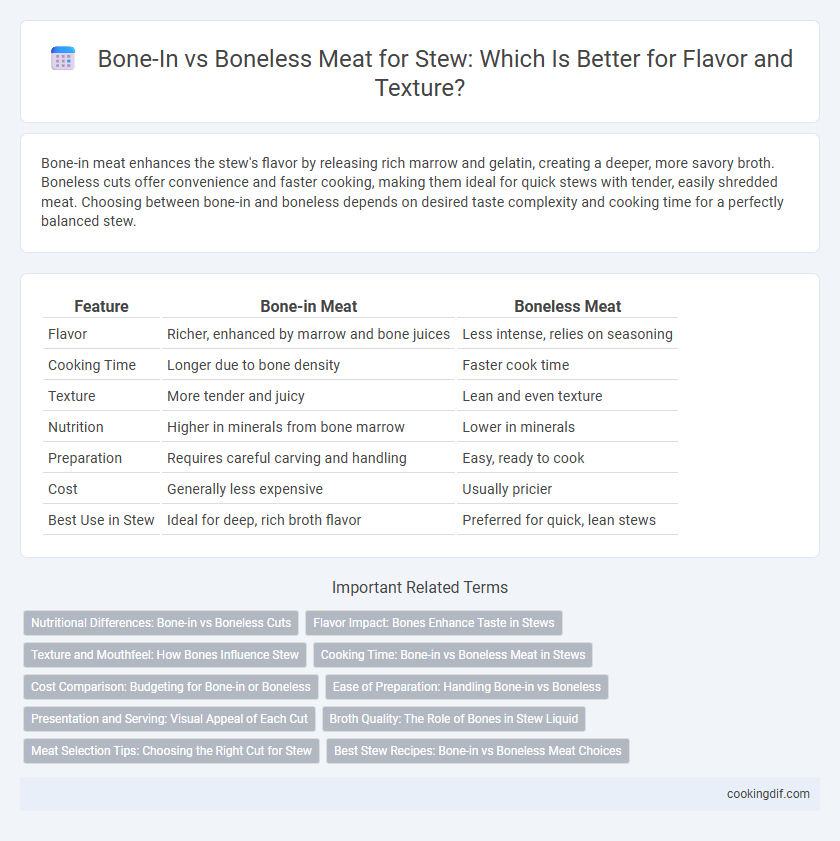Bone-in meat enhances the stew's flavor by releasing rich marrow and gelatin, creating a deeper, more savory broth. Boneless cuts offer convenience and faster cooking, making them ideal for quick stews with tender, easily shredded meat. Choosing between bone-in and boneless depends on desired taste complexity and cooking time for a perfectly balanced stew.
Table of Comparison
| Feature | Bone-in Meat | Boneless Meat |
|---|---|---|
| Flavor | Richer, enhanced by marrow and bone juices | Less intense, relies on seasoning |
| Cooking Time | Longer due to bone density | Faster cook time |
| Texture | More tender and juicy | Lean and even texture |
| Nutrition | Higher in minerals from bone marrow | Lower in minerals |
| Preparation | Requires careful carving and handling | Easy, ready to cook |
| Cost | Generally less expensive | Usually pricier |
| Best Use in Stew | Ideal for deep, rich broth flavor | Preferred for quick, lean stews |
Nutritional Differences: Bone-in vs Boneless Cuts
Bone-in cuts provide higher mineral content, especially calcium and phosphorus, due to marrow and bone marrow nutrients seeping into the stew. Boneless cuts typically contain slightly more protein per serving, as they consist purely of muscle meat without bone weight. Selecting bone-in meat enhances the stew's nutritional profile by adding essential minerals and richer flavor compounds derived from the bones during cooking.
Flavor Impact: Bones Enhance Taste in Stews
Bone-in meat significantly enhances the flavor profile of stews by releasing collagen and marrow during slow cooking, resulting in a richer, more savory broth. The minerals and gelatin extracted from bones contribute to a deeper mouthfeel and complex umami notes that boneless cuts lack. Choosing bone-in meat elevates the overall taste experience, making stews more robust and satisfying.
Texture and Mouthfeel: How Bones Influence Stew
Bone-in meat enhances stew by releasing collagen and marrow during cooking, resulting in a richer, silkier texture and deeper mouthfeel. The presence of bones helps maintain the meat's moisture and tenderness, creating a more succulent bite compared to boneless cuts. Boneless meat tends to produce a less complex broth and a drier mouthfeel due to the absence of marrow infusion and collagen breakdown.
Cooking Time: Bone-in vs Boneless Meat in Stews
Bone-in meat typically requires longer cooking times in stews due to the density and presence of connective tissue around the bone, which slowly breaks down to enhance flavor and tenderness. Boneless meat cooks faster, making it ideal for quicker stews, but may lack the rich, gelatinous texture that bones impart during prolonged simmering. Choosing between bone-in and boneless cuts depends on desired stew consistency and available cooking time, as bone-in offers depth at the cost of extended preparation.
Cost Comparison: Budgeting for Bone-in or Boneless
Bone-in meat typically costs less per pound than boneless cuts, offering more flavor and richness to stews without breaking the budget. Boneless meat provides convenience and quicker cooking times but often comes at a higher price, impacting overall stew preparation costs. Choosing bone-in options can maximize meat yield and enhance broth complexity while maintaining affordable meal planning.
Ease of Preparation: Handling Bone-in vs Boneless
Boneless meat offers greater ease of preparation due to quicker trimming and more uniform cooking times, making it ideal for stews requiring fast and consistent heat distribution. Bone-in cuts enhance flavor but demand more handling, such as careful deboning after cooking and longer simmering to extract richness. Choosing boneless simplifies the cooking process, while bone-in requires patience but rewards with deeper, more complex flavors.
Presentation and Serving: Visual Appeal of Each Cut
Bone-in meat enhances stew presentation with its rustic, hearty appearance, offering natural structure that retains juices and imparts rich flavor. Boneless cuts provide a uniform, clean look, making it easier to serve bite-sized, tender pieces that appeal to diners seeking convenience. Visual appeal in stew balances the rustic charm of bone-in cuts with the refined, neat presentation of boneless meat, influencing serving style and guest experience.
Broth Quality: The Role of Bones in Stew Liquid
Bones contribute essential collagen and marrow that enrich the broth with a deep, savory flavor and a silky texture, enhancing the stew's overall mouthfeel. The gelatin released from bone-in meat thickens the liquid naturally, creating a rich, velvety consistency that boneless cuts often lack. Choosing bone-in meat elevates broth quality by infusing mineral nutrients and umami compounds vital for a well-balanced stew.
Meat Selection Tips: Choosing the Right Cut for Stew
Bone-in meat enhances stew flavor by releasing collagen and marrow during slow cooking, enriching the broth's richness and texture. Boneless cuts, such as chuck or brisket, offer ease of preparation and consistent tenderness, perfect for quick or pressure cooker stews. Selecting well-marbled cuts with balanced fat content ensures optimal moisture retention and succulent meat in every stew bite.
Best Stew Recipes: Bone-in vs Boneless Meat Choices
Bone-in meat infuses stews with rich, gelatinous flavors from marrow and connective tissues, enhancing broth depth and texture. Boneless cuts offer convenience and faster cooking times, making them ideal for quick stews or recipes requiring tender, uniform pieces. Choosing between bone-in and boneless depends on desired flavor intensity and cooking method, with bone-in preferred for slow-simmered, hearty stews and boneless suited for faster preparations.
Bone-in vs Boneless for meat selection Infographic

 cookingdif.com
cookingdif.com